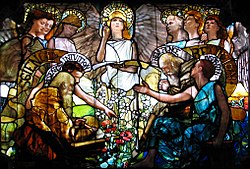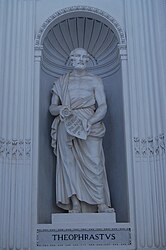Portal:Philosophy/FP/Archive
An archive of images featured on the Philosophy Portal
| This page is currently inactive and is retained for historical reference. Either the page is no longer relevant or consensus on its purpose has become unclear. To revive discussion, seek broader input via a forum such as the village pump. |
| Note: Image entries are now being transcluded directly on the main portal page. However, this page should be retained for historical reference. |
These images previously appeared (or shall appear) on the Philosophy Portal as scheduled below. You can add the automatically updating Picture of the week to your userpage or talk page using {{philosophy image of the week}}.
Portal:Philosophy/FP/1
Portal:Philosophy/FP/2
Portal:Philosophy/FP/3
Portal:Philosophy/FP/4
Portal:Philosophy/FP/5
Portal:Philosophy/FP/6
Portal:Philosophy/FP/7
Portal:Philosophy/FP/8
Portal:Philosophy/FP/9
Portal:Philosophy/FP/10
Portal:Philosophy/FP/11
Portal:Philosophy/FP/12
Portal:Philosophy/FP/13
Portal:Philosophy/FP/14
Portal:Philosophy/FP/15
Portal:Philosophy/FP/16
Portal:Philosophy/FP/17
Portal:Philosophy/FP/18
Portal:Philosophy/FP/19
Portal:Philosophy/FP/20
Portal:Philosophy/FP/21
Portal:Philosophy/FP/22
Portal:Philosophy/FP/23
Portal:Philosophy/FP/24
| This page is currently inactive and is retained for historical reference. Either the page is no longer relevant or consensus on its purpose has become unclear. To revive discussion, seek broader input via a forum such as the village pump. |
| Note: Image entries are now being transcluded directly on the main portal page. However, this page should be retained for historical reference. |

|
Philosophy, (1896) a mural by Robert Lewis Reid located in the North Corridor on the Second Floor of the Library of Congress Thomas Jefferson Building, Washington, D.C. the caption underneath reads: "HOW CHARMING IS DIVINE PHILOSOPHY." |
| This page is currently inactive and is retained for historical reference. Either the page is no longer relevant or consensus on its purpose has become unclear. To revive discussion, seek broader input via a forum such as the village pump. |
| Note: Image entries are now being transcluded directly on the main portal page. However, this page should be retained for historical reference. |

|
The center third of Education (1890), a stained glass window by Louis Comfort Tiffany and Tiffany Studios, located in Linsly-Chittenden Hall at Yale University. It depicts Science (personified by Devotion, Labor, Truth, Research and Intuition) and Religion (personified by Purity, Faith, Hope, Reverence and Inspiration) in harmony, presided over by the central personification of "Light·Love·Life". |
| This page is currently inactive and is retained for historical reference. Either the page is no longer relevant or consensus on its purpose has become unclear. To revive discussion, seek broader input via a forum such as the village pump. |
| Note: Image entries are now being transcluded directly on the main portal page. However, this page should be retained for historical reference. |

|
Plato (left) and Aristotle (right), a detail of The School of Athens, a fresco by Raphael. Aristotle gestures to the earth, representing his belief in knowledge through empirical observation and experience, while holding a copy of his Nicomachean Ethics in his hand, whilst Plato gestures to the heavens, representing his belief in The Forms. |
| This page is currently inactive and is retained for historical reference. Either the page is no longer relevant or consensus on its purpose has become unclear. To revive discussion, seek broader input via a forum such as the village pump. |
| Note: Image entries are now being transcluded directly on the main portal page. However, this page should be retained for historical reference. |

|
|
| This page is currently inactive and is retained for historical reference. Either the page is no longer relevant or consensus on its purpose has become unclear. To revive discussion, seek broader input via a forum such as the village pump. |
| Note: Image entries are now being transcluded directly on the main portal page. However, this page should be retained for historical reference. |

|
|
| This page is currently inactive and is retained for historical reference. Either the page is no longer relevant or consensus on its purpose has become unclear. To revive discussion, seek broader input via a forum such as the village pump. |
| Note: Image entries are now being transcluded directly on the main portal page. However, this page should be retained for historical reference. |

|
|
Portal:Philosophy/FP/31 Portal:Philosophy/FP/32 Portal:Philosophy/FP/33 Portal:Philosophy/FP/34 Portal:Philosophy/FP/35 Portal:Philosophy/FP/36 Portal:Philosophy/FP/37
| This page is currently inactive and is retained for historical reference. Either the page is no longer relevant or consensus on its purpose has become unclear. To revive discussion, seek broader input via a forum such as the village pump. |
| Note: Picture entries are now being transcluded directly on the main portal page. However, this page should be retained for historical reference. |

Portal:Philosophy/FP/39 Portal:Philosophy/FP/40 Portal:Philosophy/FP/41 Portal:Philosophy/FP/42 Portal:Philosophy/FP/43 Portal:Philosophy/FP/44 Portal:Philosophy/FP/45 Portal:Philosophy/FP/46 Portal:Philosophy/FP/47 Portal:Philosophy/FP/48 Portal:Philosophy/FP/49 Portal:Philosophy/FP/50 Portal:Philosophy/FP/51 Portal:Philosophy/FP/52
| This page is currently inactive and is retained for historical reference. Either the page is no longer relevant or consensus on its purpose has become unclear. To revive discussion, seek broader input via a forum such as the village pump. |
| Note: Image entries are now being transcluded directly on the main portal page. However, this page should be retained for historical reference. |
Today is Thursday, January 23, 2025; it is now 02:14 UTC
